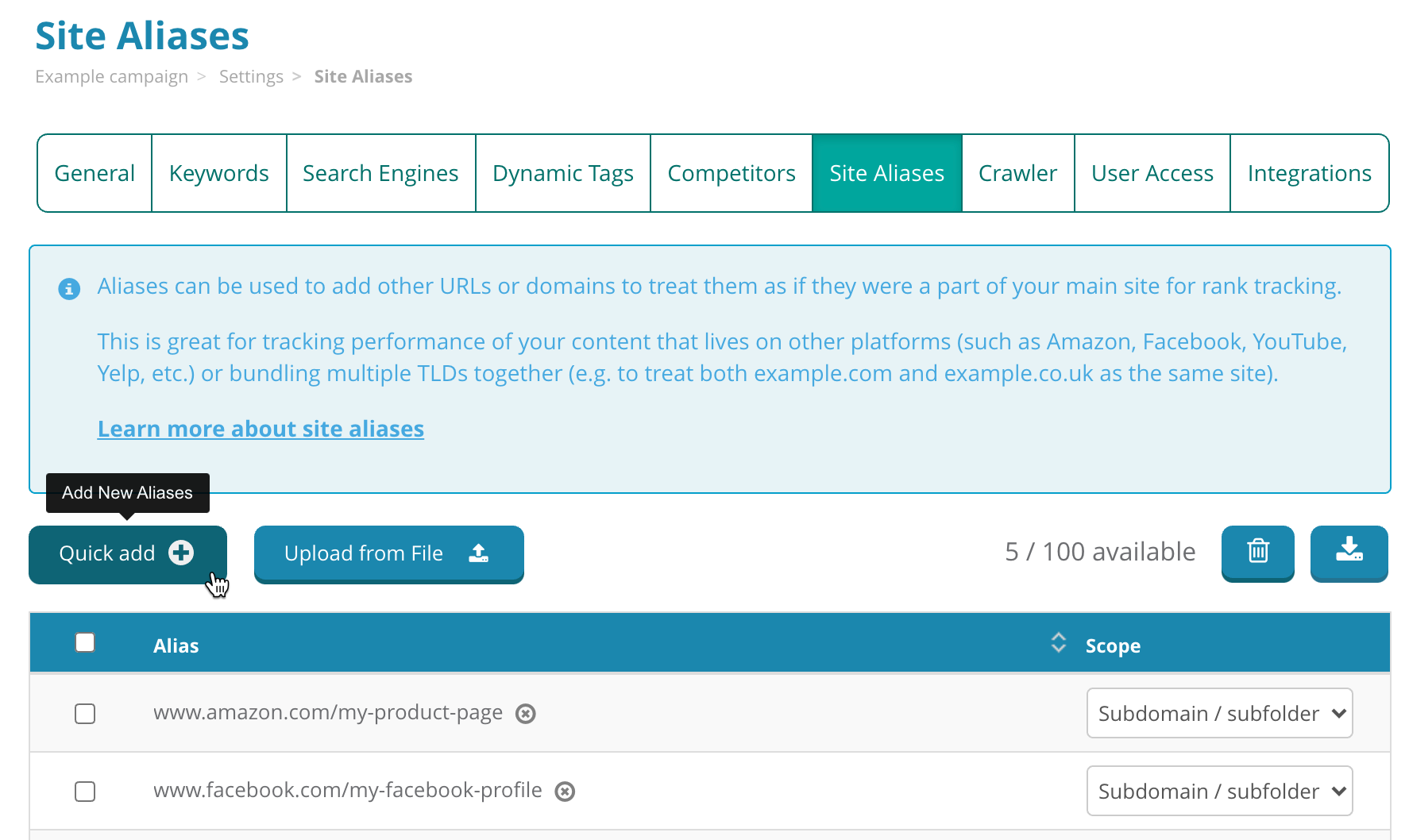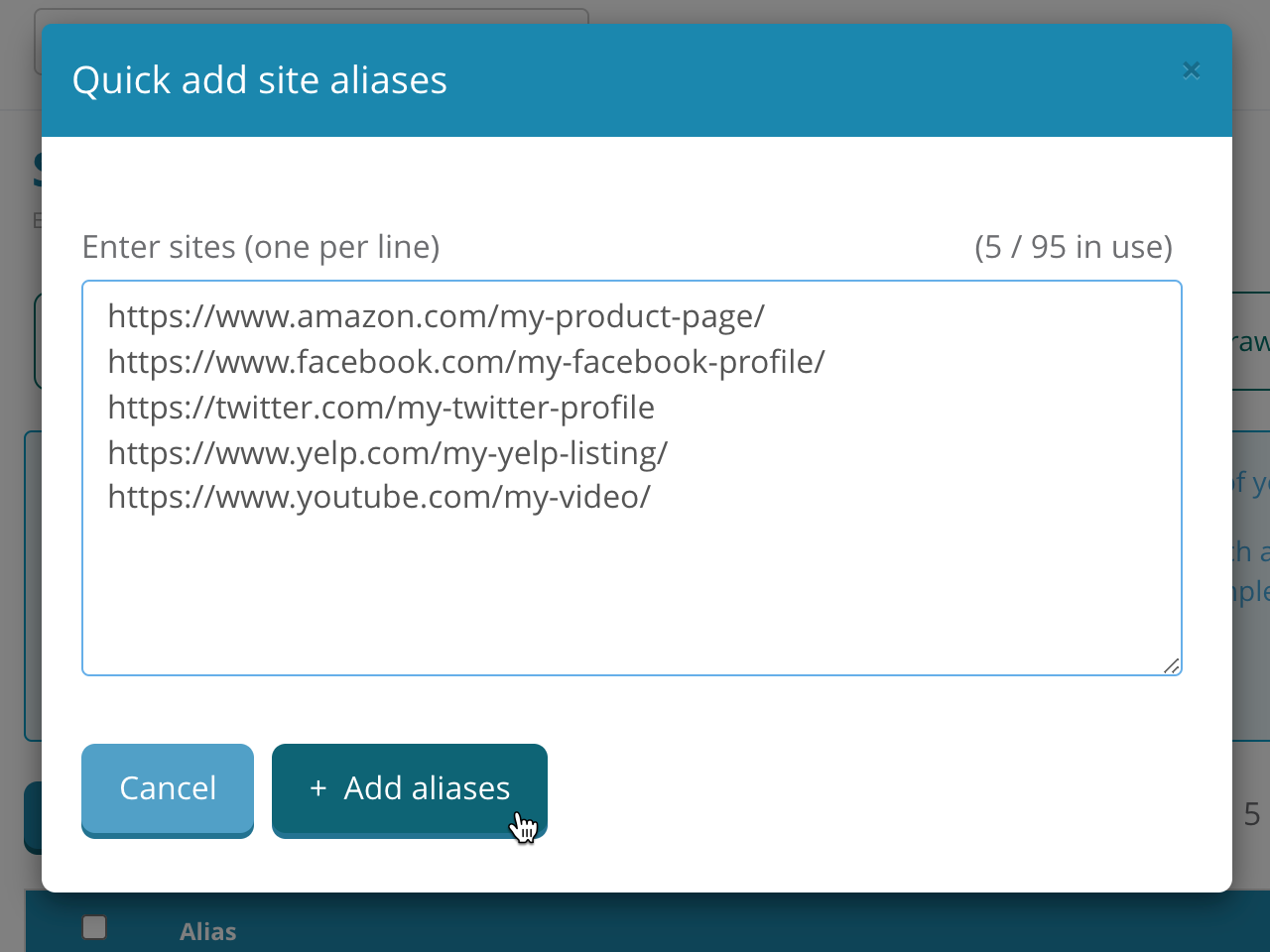Track All Your Content from Across the Web with Site Aliases

Today we’re excited to announce the official launch of one of our most-requested features of all time — Site Aliases!
Site Aliases let you track your content’s ranking, no matter where it lives on the web. Now you can track your Facebook profile, Twitter profile, YouTube channel, Yelp profile, or any other URL or site as if it were a part of your main site.
Up until now, Dragon Metrics let you track a single root domain, subdomain, subfolder, or URL as “your site” in campaigns. This flexible solution works for traditional use cases, but over the years we’ve noticed there are use cases that fall outside of this.
For example:
In each of these situations, you could be thinking “That’s okay with me, but why does Dragon Metrics show that I’m not ranking for this keyword?"
Site Aliases fixes all of this by letting you upload a list of URLs and sites that should be treated exactly the same as if it were your main site ranking on the SERP.
It’s simple to add Site Aliases to campaign. Simply navigate to Site Aliases (under Campaign Settings in the bottom right of every page).

Click Quick add to enter a list of sites (URLs, domains, subdomains, or subfolders) you’d like to track the same as your site.

You’re done! Now any time these site aliases appear on the SERP for any tracked keywords, when you visit any ranking report in Dragon Metrics, the ranking will be shown just as if it were your main campaign’s site ranking at this position. It’s that easy!
The concept of Site Aliases is simple enough, but how could this benefit your brand? Let’s take a look at some of the most use cases brands will want to leverage Site Aliases for.
If your social media profile or posts are ranking for your targeted keywords, and you consider this a win (even if your site’s domain is ranking lower or not at all), you’ll want to add your social accounts as Site Aliases.
Use the main URL of your social media profiles (or subfolder in some cases to include URLs of specific posts), for example https://www.youtube.com/user/your-youtube-channel/ or https://twitter.com/your-twitter-username/.
If your site has multiple ccTLDs (country code top-level domains, e.g. example.co.uk and example.de), you can track them all together in a single campaign as your site.
An incredibly common scenario: You’re tracking keywords in the UK, but your UK site (example.co.uk) is being outranked by your US site (example.com). No worries — set your UK campaign’s main site as example.co.uk and add example.com as a Site Alias. While you’re at it, you might want to add all of your other international sites too (such as example.au and example.co.nz)!
Not all content you own is found on your website. Sometimes the approach of barnacle SEO, or more plainly “If you can’t beat ‘em, join ‘em” is the right approach for high-difficulty keywords.
Google loves showing YouTube videos on the SERP, so if you’re publishing great video content on the platform, you’ll want to enter a list of all of your video’s YouTube URL as Site Aliases to see where they’re ranking on the SERP.
If you’ve published articles on medium.com that you want considered as “your site”, add your posts’ URLs as Site Aliases.
It can be tricky to rank your website’s content on Baidu, especially if you’re not hosting locally in China. That’s why we’ve seen a lot of smart SEOs publish their brand’s content on Baidu’s own properties (such as Zhidao), which tend to rank much better than their own site on baidu.com. Upload your list of URLs published on Baidu’s properties as Site Aliases to track their performance.
Without Site Aliases, you can track your site as a root domain, subdomain, subfolder, or URL. But what if you want to track some parts of your domain, but not all? Site Aliases to the rescue!
If you only want to track ***www.***example.com and ***products.***example.com, but exclude all other subdomains, you can add www.example.com as the main campaign site and products.example.com as a Site Alias.
Perhaps Johnson & Johnson is tracking the keyword “pain killer” and wants to see their highest ranking URL regardless of which brand it is. They may consider adding jnj.com as their main campaign site, along with tylenol.com and motrin.com as Site Aliases.
Maybe you didn’t write the content, it’s not on a site you own, and maybe you don’t even know the writer / publisher. However, the content is praising your brand or presents your brand in a positive light.
If you just want to track sites that have positive mentions of your brand, simply add a list of URLs that have content that you don’t mind ranking #1 for your targeted keywords as Site Aliases.
If your brand’s Yelp profile is ranking well for your targeted keywords, you may want to track it as a Site Alias.
The above examples are just some suggestions of popular use cases we’ve encountered over the years, but Site Aliases is so flexible and powerful, the sky is the limit!
Give it a try today, and let us know of any unique use cases you find!